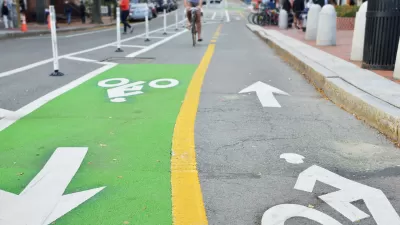It turns out that the “law of demand” (the tendency of higher prices to reduce consumption) and the principles of urban economics (that improved accessibility increases land values) still apply. If we are smart, we can use these to help solve problems and benefit consumers.
It turns out that the "law of demand" (the tendency of higher prices to reduce consumption) and the principles of urban economics (that improved accessibility increases land values) still apply. If we are smart, we can use these to help solve problems and benefit consumers.
It took a while, but there is mounting evidence that rising fuel prices are reducing fuel consumption and vehicle travel. Between 2006 and 2007 average Regular gasoline prices increased about 9%, from $2.53 to $2.77 per gallon, and according to Federal estimates, annual U.S. vehicle miles traveled (VMT) declined about 0.4 percent in total, or about 1.3% per capita, indicating a short-run elasticity of about 15%. Between Januarys 2007 and 2008, California average gasoline prices increased about 25%, from $2.62 to $3.30 per gallon, and gasoline consumption declined 4.5% in total, or about 6% per capita, indicating a short-run price elasticity of about -0.23. Long-run elasticities (more than five years) are typically about three times larger, or about -0.5 to -0.7, which is pretty typical historically (Transportation Elasticities).
Recent analysis by the Sightline Institute found that Pacific Northwest fuel consumption is declining even more than the national average, apparently because cities such as Portland and Seattle are improving alternative modes and land use accessibility (Northwesterners Easing Up On Gas). A study by the U.S. Congressional Budget Office found similar patterns: on freeways with parallel rail transit services rising fuel prices tend to reduce vehicle traffic volumes and increase transit ridership, but no such effect was found on freeways that lack grade separated transit (Effects of Gasoline Prices on Driving Behavior and Vehicle Markets). Conventional wisdom now recognizes that the law of demand applies to driving.
Why does it take so long? There is often a lag period between when fuel prices increase and behavior changes (consumers must realize that price increases are not just temporary spikes), and price responses increase as fuel costs represent an increasing portion of household expenditures. Consumers are now motivated to reduce driving and shift to more fuel efficient vehicles.
Similar changes are occurring in real estate markets. The value of housing in automobile-dependent locations appears to be declining significantly (Home Prices Drop Most in Areas with Long Commute). This is unsurprising. When fuel cost $1.50 per gallon, choosing an automobile-dependent home that requires an extra 20,000 annual household vehicle-miles added $1,500 in annual fuel expenses, but at $3.50 per gallon this increases to $3,500. The total vehicle cost differential, including additional vehicle depreciation, maintenance and repairs, are about double this amount. In other words, choosing a more accessible home location, where residents can drive less and rely more on alternative modes now saves a typical household about $7,000 annually in transportation expenses, allowing $100,000 to $200,000 in additional investment. As a result, sprawled locations lose value relative to smart growth (The Next Slum).
Of course, fuel costs are only one of many factors that affect consumers' home location decisions. Other trends also support shifts to more accessible, multi-modal home locations, where residents can drive less and rely more on walking, cycling and public transportation, including aging population, increasing traffic congestion, increasing health concerns, and growing preference for urban living by many consumers. All of this suggests that consumers are ready to accept more transportation efficient lifestyles, provided that markets provide suitable options, for example, by improving walking and cycling conditions, increasing public transit service quality, and creating more transit-oriented communities (Hidden In Plain Sight: Capturing The Demand For Housing Near Transit).
This is actually good news overall, if we act rationally (Appropriate Response To Rising Fuel Prices). Reduced driving and fuel consumption, shifts to alternative modes, and more accessible development help reduce many problems including traffic congestion, road and parking facility costs, accidents, energy production externalities, pollution emissions, and health problems associated with sedentary living. But achieving these benefits will require changing our transportation and land use policies to reflect shifting consumer demands.

Planetizen Federal Action Tracker
A weekly monitor of how Trump’s orders and actions are impacting planners and planning in America.

Map: Where Senate Republicans Want to Sell Your Public Lands
For public land advocates, the Senate Republicans’ proposal to sell millions of acres of public land in the West is “the biggest fight of their careers.”

Restaurant Patios Were a Pandemic Win — Why Were They so Hard to Keep?
Social distancing requirements and changes in travel patterns prompted cities to pilot new uses for street and sidewalk space. Then it got complicated.

Platform Pilsner: Vancouver Transit Agency Releases... a Beer?
TransLink will receive a portion of every sale of the four-pack.

Toronto Weighs Cheaper Transit, Parking Hikes for Major Events
Special event rates would take effect during large festivals, sports games and concerts to ‘discourage driving, manage congestion and free up space for transit.”

Berlin to Consider Car-Free Zone Larger Than Manhattan
The area bound by the 22-mile Ringbahn would still allow 12 uses of a private automobile per year per person, and several other exemptions.
Urban Design for Planners 1: Software Tools
This six-course series explores essential urban design concepts using open source software and equips planners with the tools they need to participate fully in the urban design process.
Planning for Universal Design
Learn the tools for implementing Universal Design in planning regulations.
Heyer Gruel & Associates PA
JM Goldson LLC
Custer County Colorado
City of Camden Redevelopment Agency
City of Astoria
Transportation Research & Education Center (TREC) at Portland State University
Camden Redevelopment Agency
City of Claremont
Municipality of Princeton (NJ)




























